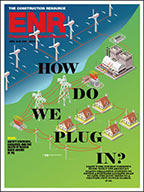The world's largest solar thermal powerplant is nearing completion in the Ivanpah Dry Lake, 50 miles northwest of Needles, Calif. Comprising three units that will begin staged operation in the fourth quarter, the 377-MW Ivanpah complex will generate enough electricity for 140,000 homes and displace more than 400,000 tons of carbon dioxide emissions annually, says the owner-developer.
BrightSource Energy Inc., Oakland, has power-purchase agreements in place with PG&E and Southern California Edison. By generating more than 1-million-MWh annually, the $2.2-billion plant will nearly double U.S. commercial solar thermal capacity.
San Francisco-based Bechtel Corp., the engineering, procurement and construction contractor, broke ground in October 2010. "The scale and complexity of the Ivanpah project presented first-of-a-kind construction challenges that required innovative thinking and execution at every level," says Jim Ivany, Bechtel's former president of renewable power, who now works in the company's oil, gas and chemicals division. "We created lean approaches to multiple phases of the project, enabling the team to successfully advance the project."
NRG Energy Inc., Princeton, N.J., has invested $300 million into the development, which sits on 3,471 acres of federally owned desert land in San Bernardino County, five miles west of the Nevada border. Internet giant Google also invested $168 million in the 5.5-sq-mile project, which has a $1.6-billion loan guarantee from the U.S. Dept. of Energy.
The facility consists of 173,500 heliostats, or reflective mirrors that resemble shiny billboards. Each heliostat consists of two flat 10.5-ft by 7.5-ft mirrors held in place by a six-arm steel frame, supplied by Gestamp Renewables, part of Spanish-based Corporacion Gestamp.
Each heliostat is supported by an 11-ft-long, 6-in.-dia steel pylon that has been vibrated into the ground for an eco-friendly alternative to using concrete foundations. "The uniqueness of the heliostat assembly process is the simplicity," says Hagai Huss, BrightSource solar field manager. "We are producing a heliostat every 1.7 minutes. Every day, we need to assemble 500 heliostats."
Although each pylon has a three-fin base to control rotation, heliostats go into a safe mode if winds reach 31.3 mph.
Software-controlled, 161-sq-ft aperture heliostats track the sun throughout the day using two independent drives from Cone Drive Gearing Solutions, Traverse, Mich., which rotate both vertically and horizontally. Workers assembled and installed heliostats on-site at a rate of up to 700 a day. The undertaking uses roughly 435 miles of electrical wire and 64 miles of conduit.
Lighthouse in Reverse
The sea of mirrors concentrates sunlight to three 120-ft-tall solar-receiver steam generators perched atop a trio of 339-ft-high steel X-braced towers, essentially like a lighthouse in reverse. The 459-ft-tall structures—each one and a half times taller than the Statue of Liberty—were erected using three 100-ton, 550-ft-tall Favelle Favco M1280D luffing tower cranes. The self-climbing cranes were attached to the tubular steel towers, each anchored by a 100-ft-sq by 9-ft-deep footing foundation comprising 4,600 cu yd of concrete.







